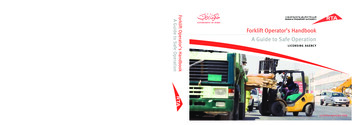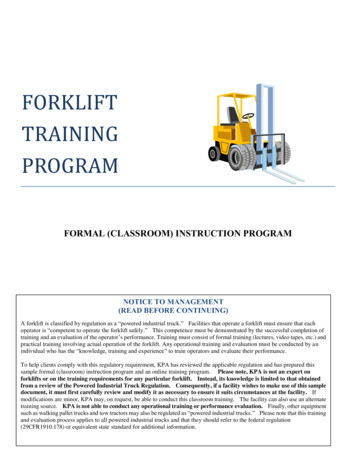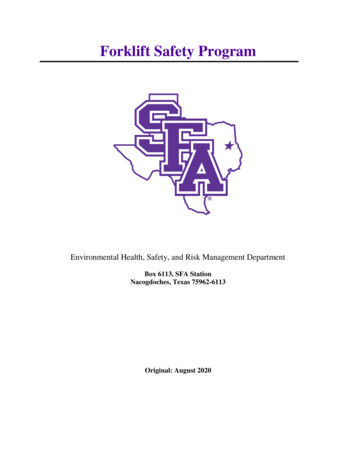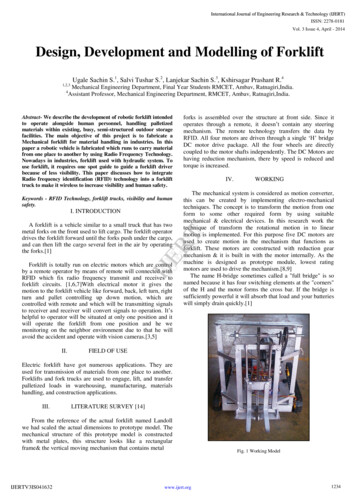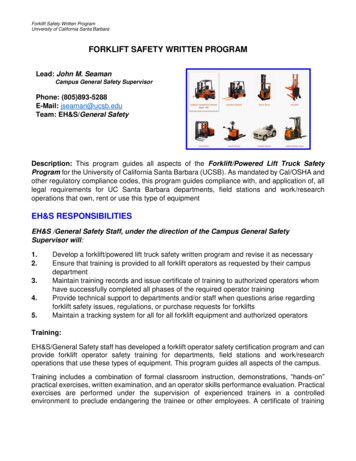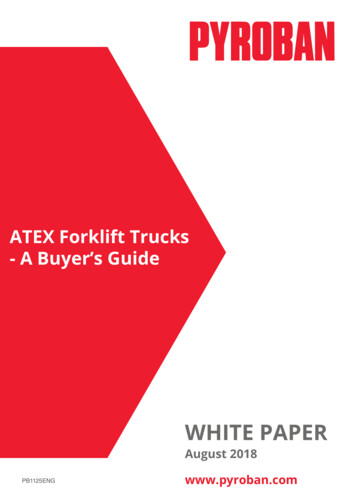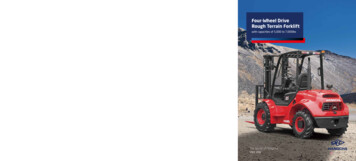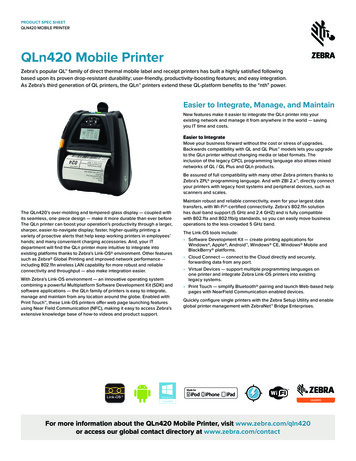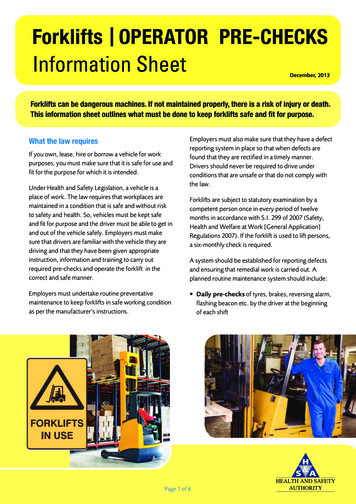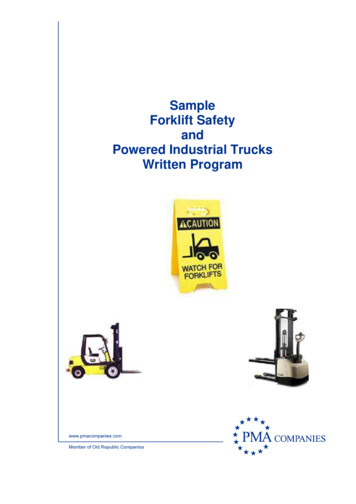
Transcription
SampleForklift SafetyandPowered Industrial TrucksWritten Program
IMPORTANT NOTICE: This risk control Sample Program provided by PMA Companies isintended to help support your loss prevention efforts. It is not intended to be complete ordefinitive in discovering or identifying all hazards associated with your business, preventingworkplace accidents, or complying with any safety related or other laws or regulations. You areencouraged to address the specific hazards of your business and have your legal counselreview all of your plans and company policies.2
Table of Contents1.Purpose2.Responsibilities3.Types of Equipment & Usage4.Program Training & Activities5.Equipment Inspection & Maintenance6.Safety Rules7.AppendixA.B.C.D.Forklift Certification CardMaintenance and Inspection FormsPowered Industrial Truck Training GuideSample Post Training Participant Quiz3
Powered Industrial Truck Safety Written Training ProgramForDealership Name1. PurposeThe purpose of this program is to train all employees who are using powered industrialtrucks how to use them safely. The program will address all parties involved as wellas activities that will be done in the program.This program works within the OSHA compliance guidelines for powered industrialtrucks which are found in 29 CFR 1910.178. This program is meant for the use of allemployees who are using powered industrial trucks at (Dealership Name)2. Parties Responsible:Program Director:Employee nameThe director is responsible for: Issuing and administering this program and making sure that it is compliant withall current OSHA safety requirements for the operation and use of a poweredindustrial truck. Providing Initial and refresher training to all employees who are able to use thepowered industrial truck. Conducting powered industrial truck evaluations. Maintaining and updating all powered industrial truck certification records fordealership. Scheduling all maintenance for powered industrial trucks. If maintenance is provided by in-house staff, be sure Lock Out/Tag Outprocedures are followed, and be sure all inspection forms are complete.Managers & Supervisors:Managers and supervisors are responsible for: Making sure all employees that use the powered industrial trucks are receivingthe proper training from the program director. Monitoring employee usage of the powered industrial trucks and informing theprogram director when refresher training is needed, or if training is needed for anew operator.4
Powered Industrial Truck MaintenanceMaintenance is organized through the program director. See responsibilities notedabove.Powered Industrial Truck OperatorsPowered industrial truck operators are responsible for: Operating powered industrial trucks within the guidelines and rules of safetyestablished by the dealership.Performing daily inspections on all powered industrial trucks before operation.Informing all management personnel of safety violations and mechanical repairthat need to be made on all powered industrial trucks.3. Types of Equipment and UsageThe following equipment used at this dealership meets the requirements for poweredindustrial tucks and therefore must follow the guidelines outlined in this program.Powered industrial trucks are any mobile materials handling equipment that ispowered by means of internal combustion engine, compressed gas, electricity,battery, pneumatic or hydraulic fluid.Equipment TypeDepartment5
4. Program Training & ActivitiesTraining Only the program director who is well trained in the use of the power industrialtrucks which are used at the dealership can provide employee training on howto use a power industrial truck. EXCEPTION- powered industrial truck vendorwill sometimes offer this employee training. Only employees who are certified in the equipment being operated will beallowed to use it. (See Appendix A for sample certification form) The certification process contains classroom training, practical applicationthrough operating the power industrial truck, evaluation/ certification andrecertification every 3 years. (See Appendix C for a sample safety training guide) The following principles will be taught to employees regarding the use ofpowered industrial trucks. Differences between the truck and the automobile. Truck controls and instrumentation: where they are located, whatthey do, and how they work. Engine or motor operation. Steering and maneuvering. Visibility (including restrictions due to loading). Fork and attachment adaptation, operation, and use limitations. Vehicle capacity. Vehicle stability. Any equipment &/or truck inspection and maintenance that theoperator will be required to perform. Refueling and/or charging and recharging of batteries. Operating limitations6
Workplace-related Topics [29 CFR 1910.178(l)(3)(ii)] Surface conditions where the vehicle will be operated. Composition of loads to be carried and load stability. Load manipulation, stacking, and unstacking. Pedestrian traffic in areas where the vehicle will be operated. Narrow aisles and other restricted places where the vehicle will beoperated. Hazardous (classified) locations where the vehicle will beoperated. Ramps and other sloped surfaces that could affect the vehicle'sstability. Closed environments and other areas where insufficient ventilationor poor vehicle maintenance could cause a buildup of carbonmonoxide or diesel exhaust.If an operator was previously trained in one of these topics, and the training is appropriate to the truckand working conditions encountered, additional training on that topic is not required provided that theoperator has been evaluated and found competent to operate the truck safely. However, theseoperators will still need their certifications updated every three years.Trainees may operate a powered industrial truck only: Under the direct supervision of persons who have the knowledge, training, andexperience to train operators and evaluate their competence. Where such operation does not endanger the trainee or other employees.Note: Only Adults above the age of 18 are allowed to use powered industrialtrucks.Ref: tance/index.html#training7
5. Inspections and Schedule/Emergency Maintenance All powered industrial trucks that are in use will be inspected each morningbefore use. Inspection reports will be completed, signed and dated after each inspection. Inspection reports will be filed at the end of each day with the programdirector. Exception: Inspection reports may be kept on the powered industrialtruck for reference, provided that they are reviewed by the program directormonthly. If repairs are needed on the powered industrial trucks, then the equipment willbe taken out of service immediately. Before a powered industrial truck can go into regular service after beingrepaired it must pass an operational test to make sure that it is fit for duty (SeeAppendix)6. Operating of the Power Industrial TruckSafety Rules A speed limit should be observed for power industrial trucks in the facility at alltimes. If the operator’s vision is disrupted at any time, the power industrial truck shouldnot be used until the disruption is removed. Important: To be used effectively (and safely) to lift an employee, a specialattachment, designed and approved for such purposes must be used. Thisattachment is commonly referred to as a basket-lift or man-lift. Never allow anindividual to stand on the forks for any reason. The employee must be tied off tothe basket/lift using approved safety harness and lanyard, and the basket-liftmust be secure to the forks according to manufacturer’s specifications. Thebasket-lift must be equipped with a toe board and the employee workspace mustbe “gated off”. Only stable safe loads must be handled by the operator when using the truck.Operators must be trained in determining the safe load capacity of the unit priorto operation. Capacity must never be exceeded when using the power industrial truck. All loads being transported on an incline must face upwards while traveling onthat incline. A seatbelt must be worn at all times while operating the powered industrialtruck. All powered industrial trucks must have a backup alarm or backup lights to warnothers of the approaching device. These alarms should be in inspected daily toinsure they are operating when the forklift is used.8
Gasoline All internal combustion powered industrial trucks will be refueled in designatedsafety areas through the facility. Before refueling, each truck will be turned off. At no time will any employee be allowed to smoke in or near the refueling safezone. (Enter where the safe refueling zone is located) Powered industrial trucks are never to be topped off with fuel. This could causean explosion hazard.Liquid Petroleum Gas (LPG) LPG trucks shall at no time be refueled in a confined environment. LPG trucks shall never be left near heat sources or in places where exit andegress is made more difficult by the truck being present. Only a certified, designated employee may replace fuel tanks for the LPGpowered industrial trucks. This is generally the program manager. All LPG tanks will be stored in accordance with OSHA mandated guidelines.Battery DrivenAll battery driven trucks will be recharged in designated safety areas throughthe dealershipout29 CFR1910.178(g)(1) clearly states that “Battery charging installations shall belocated in areas designated for that purpose.” The standard further states: The battery charging station must be located in a well ventilated, open-airenvironment. Smoking is prohibited in and around power industrial trucks at all times. There should be no open flames or sparks present in the recharging areas. Personal protective equipment should be worn at all times by all employeesworking on, in or near power industrial trucks. When handling electrolyte solutionor inspecting battery fluid levels, appropriate personal protective equipment mustbe worn. This shall include appropriate chemical resistant gloves, chemicalgoggles, face shield, apron or other items designed to prevent splashing orspilling chemical from contacting the operator. An eye wash and first aid kit should be located in the immediate vicinity of therecharging area. A water source must be located in the immediate vicinity of the recharging areato treat exposures to battery acid.9
Appendix A – Sample Certification CardThis is to certify thatHas Completed the Powered Industrial TruckOperator Training ProgramPresented by: (Enter Name of Dealer Here)DateExpiration DateInstructor10
Appendix B – Sample Maintenance & Inspection FormForklift Operator ChecklistItems that need to be checked daily or before you use the forklift. Check off the items that areok and list items that need to be repaired at the 17.18.19.20.21.22.Visual check for leaksFuelEngine CoolantBattery and CablesFire ExtinguisherTires for inflationInside cab cleanOil LevelsGrease forksPins on ForksDrive BeltsLights and Safety EquipmentWheel LugsHosesWater in RadiatorBack-up Alarm/HornFilters Clean if NeededBrakes/Clutch/SteeringParking BrakeSeat Belt, if equippedOther (A)Other (B)ID NumberAfter completion send/file (to/at):List maintenance items that need to be corrected by mechanic or vendor:SignatureDate11Printed Name
Appendix C – Powered Industrial Truck Training Guide1. Operators shall receive training in the following forklift related topics:a.b.c.d.e.f.g.h.i.Operating InstructionsTruck controls and instrumentationSteering and maneuveringStoppingVisibility (including restrictions due to loading)Fork and attachment adaptation, operation, and use limitationsVehicle capacity and stabilityVehicle maintenance and inspectionRefueling and/or the recharging of batteries2. Operators shall receive training in the following work related topics:a.b.c.d.e.f.g.h.i.j.Surface conditions where the vehicle will be operatedLoad manipulation, stacking, and unstackingHow to maneuver narrow aisles, doorways, around corners and restricted areasHazardous locations where the vehicle will be operatedRamps and other sloped surfaces that could affect stabilityOther unique or potentially hazardous environmental conditionsPedestrian traffic in areas where the vehicle will be operatedWhere to park the forkliftWeight limitsDock (if required): loading and unloading trailers, wheel chocks and dock locks.3. Operators shall receive refresher training if the following occurs:a. The operator is assigned to operate a different type of vehicleb. A condition in the workplace changes that affects vehicle operationc. An incident or “near-miss” occurs involving personal injury, property/product orequipment damage.12
Appendix D – Sample Post-Training Participant QuizForklift Safety QuizDealership NameCircle T if statement is true or F if statement is false.T F1. Only trained and authorized employees should operate forklifts.T F2. The overhead guard lists the maximum weight you can carry.T F3. It’s okay to operate a forklift without a seatbelt as long as you’retraveling at a low speed.T F4. Forklifts should always get the right-of-way over pedestrians.T F5. Always sound the horn when approaching an intersection, blind corner,or person. It’s not necessary to sound the horn when backing.T F6. As you drive the forklift, keep the forks between 6 and 10 inches high.T F7. When loading more than 1 box, always place the larger and heavier boxfarthest away from the forklift support.T F8. There is never an excuse for walking under loaded forks.T F9. It is okay to run the motor for an extended period while inside a trucktrailer.T F10. When loaded on a slope, keep the load pointed up the slope.NameSignatureDate13
A. Forklift Certification Card B. Maintenance and Inspection Forms C. Powered Industrial Truck Training Guide D. Sample Post Training Participant Quiz . 4 Powered Industrial Truck Safety Written Training Program For _ Dealership Name 1. Purpose The purpose of this program is to train all employees who are using powered industrial .
